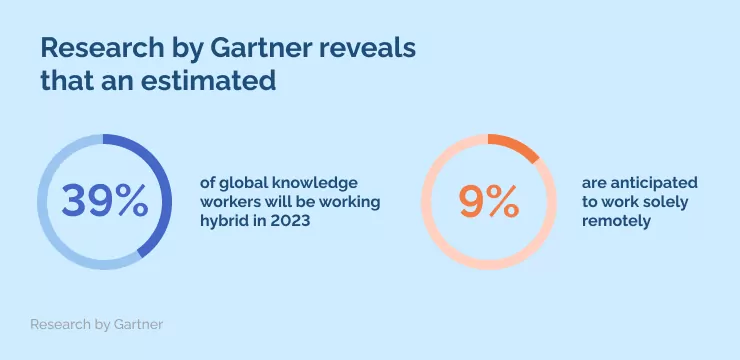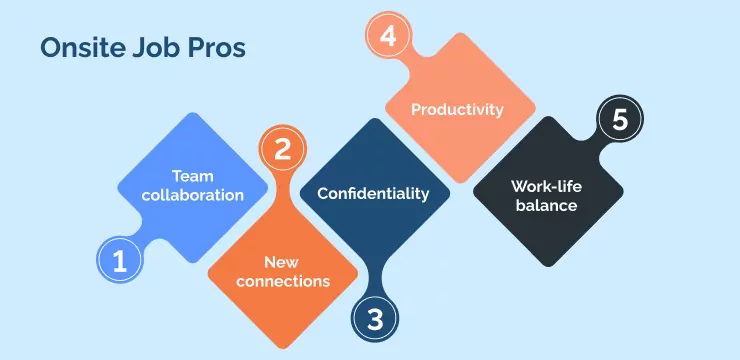
The global COVID-19 pandemic has had a massive impact on our society, including the work environment. This has led to a new definition of an onsite job, meaning more and more people are now considering this type of employment. But what does an onsite job really mean?
As a result, businesses have had to rely on new technologies to survive and have been forced to undergo rapid digital transformation and organizational change.
The ‘new normal’ has enabled flexibility amongst employees and the ability to manage their work-life balance better. However, with restrictions on social distancing and work-from-home schemes beginning to lift, organizations are now discussing how we should work in the future – on-site, off-site, remote, or hybrid.
Research by Gartner reveals that an estimated 39% of global knowledge workers will be working hybrid in 2023, a slight increase from 37% reported the year prior. In contrast, only 9% are anticipated to work solely remotely.

In this article, we explore the meaning of an onsite job and discuss the pros and cons of onsite work, compared to remote work – helping employers and clients. Employees make informed decisions about their unique professional situations.
We will also discuss how the move from an onsite job to a remote one or vice-versa can be challenging if managed poorly and offer key tips for successful change management during such transitions.
What Is Onsite Work?
Onsite work is a term used to describe a professional working arrangement in which the employee works at their employer’s physical workplace, either full-time or part-time. This could mean going into an office every day, working from home on certain days of the week, or relying on technology like Skype and cloud-based applications to interact with coworkers remotely while remaining based in their office.
An onsite job usually involves customer service, receptionist duties, project management, software development, sales, and more. Depending on the role, it may include traveling to job sites or client meetings. Onsite work means employees are physically present on the premises during regular company hours.
This can create stability for employees as they don’t have to worry about commuting and will likely be eligible for benefits provided by the employer.
Why Is Onsite Work Considered Important?
Onsite work is important to both employers and employees. Employers value onsite work because it allows them to ensure maximum productivity levels, save money on overhead costs, have direct oversight of their staff, and create a sense of cohesion within the workplace.
Employers can also benefit from offsite work in an in-person workspace that encourages team collaboration and fosters client relationships.
Employees also consider onsite work important for similar reasons. Working onsite means greater opportunities for collaboration with colleagues, better access to resources, improved communication and trust between employer and employee, and more job stability.
Being physically present in the workplace also enables people to build relationships with coworkers. It gives them an outlet for networking, learning new skills, and being a part of an organization that values their presence.
Site work usually involves clear communication of expectations and tasks, including deadlines and work in different time zones and commute times. This can include coordinating with international teams or working with remote staff. Work performed in different time zones can be challenging, as the hours may not always fit perfectly with the local schedule. Employers must provide clear guidance about expectations and tasks, and staff must be able to work flexibly.
Onsite Job Pros

Increasingly, businesses have been choosing to have their employees work onsite. This has a number of advantages that make for better team collaboration.
These include:
- Team collaboration – Having the entire team in one physical location can benefit collaboration and idea sharing. Working onsite also allows groups to form meaningful relationships that improve communication, productivity, and creativity.
- New connections – Being physically present at a workplace allows professionals to meet new colleagues and build lasting relationships. This can lead to professional growth and tapping into resources and networks to help further career goals.
- Confidentiality – Working onsite helps protect confidential information because there is less chance of data leakage or interference from outside sources.
- Productivity – There is something about being around other people and having a certain level of motivation from being surrounded by those working diligently, which can result in higher productivity.
- Work-life balance – Working onsite provides a certain amount of structure to help create a work-life balance. Employees have more control over their hours and workload when working onsite, allowing greater flexibility to find an optimal balance between their work schedule and home life. Onsite Job Cons
The traditional model of working onsite in an office environment comes with several inherent drawbacks. Common cons to working onsite include increased anxiety in the workplace, regular distractions, and less flexibility in terms of working hours and breaks. Let’s explore these potential negatives further.
Increased Anxiety – Working onsite, particularly in an office environment, can be a source of anxiety for some employees. This anxiety can manifest as feelings of being watched or judged by colleagues and supervisors and feeling overwhelmed by the pressure to perform.
Regular Distractions – In an onsite environment, it is easier to remain focused and productive when fewer distractions surround you. You may spend too much time chatting with colleagues and not completing your work. There can also be environmental distractions like traffic noise or even pets that come into the workspace.
Less Flexibility – Having a job onsite may mean less flexibility regarding working hours or taking breaks during the day, as there can be expectations to stay at the same place for a certain amount each day. This lack of flexibility can impact work-life balance and well-being if employers do not manage it properly.
Onsite vs. Remote vs. Hybrid Work
Onsite jobs refer to work on location at the business’s premises, often in an office setting. This type of job usually involves attending meetings and events and interacting with colleagues and customers face-to-face.
Remote jobs involve working from home or outside the business’s premises. These types of work typically include communicating with colleagues through video conference software or phone calls and digitally submitting work assignments. Hybrid jobs are a combination of both onsite and remote work, allowing employees to have more flexibility while working offsite while still being able to attend meetings held at the business’s premises when required.
The distinctions between these three jobs are important for employers and employees because they allow businesses to select the right model for their needs while providing workers with varying levels of freedom and structure.
Employers can choose an onsite job if they need someone who will be fully immersed in the culture and environment of their business. At the same time, remote workers allow companies to benefit from increased access to global talent pools without investing in expensive office space. Hybrid models provide a unique blend of both, allowing employees to have specialized roles within a company but still enjoy some degree of workplace autonomy and flexibility.
Transitions between onsite and remote jobs can be challenging if people are not well-managed. Key tips for successful change management include providing all team members with clear roles and expectations, effective communication from leadership, adequate support and resources for employees, and building trust in the organization.
The Future of Work
With the ‘new normal’ in full swing, hybrid work seemingly presents a new, more dynamic option for the future of work. Hybrid teams bring together professionals who can work remotely and onsite, offering greater flexibility for the organization, access to a larger talent pool, and the potential for increased productivity.
Onsite work is mainly beneficial when face-to-face interaction is needed or when responding quickly to changing circumstances; hybrid teams can often provide those same benefits while allowing employees to collaborate with colleagues worldwide in real-time. Also, hybrid teams are well-suited for companies looking to build more diverse teams with different perspectives and skill sets.
According to research from Microsoft’s Work Trend Index Special Report 22, 97% of Microsoft employees say their manager supports their desired work style.
Companies are now using different ways of doing things which are revolutionizing the business world. This means they can be more efficient and get more done while saving money. At the same time, it allows companies to benefit from new levels of innovation and offers them a lot of chances to keep growing and developing.
These new working models are creating an environment of increased flexibility, allowing businesses to adjust to the changing needs of their customer base and build a more resilient foundation. Companies can now be more agile in responding to market conditions, improving performance and growth.
By taking advantage of the latest technological advancements, businesses can reap the rewards of faster innovation cycles and higher returns on investment. As companies navigate this new terrain, they will be presented with endless opportunities to capitalize on these new working models and maximize their potential.
WalkMe Team
WalkMe spearheaded the Digital Adoption Platform (DAP) for associations to use the maximum capacity of their advanced resources. Utilizing man-made consciousness, AI, and context-oriented direction, WalkMe adds a powerful UI layer to raise the computerized proficiency, everything being equal.



